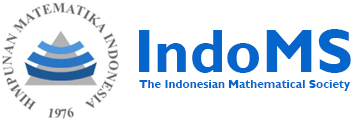Distribusi Power Gompertz-Makeham: Sifat-Sifat Statistika dan Aplikasinya
 PDF Download: 488
PDF Download: 488
DOI:
https://doi.org/10.32665/james.v6i2.1910Keywords:
Gompertz-Makeham, Metode maximum likelihood estimastion, Transformasi power, Maximum likelihood estimation method, power transformationAbstract
Pada artikel ini, kami memperkenalkan distribusi power Gompertz-Makeham (PGM) dengan empat parameter. Distribusi ini didapat melalui transformasi power pada distribusi Gompertz-Makeham. Pada distribusi baru ini, pertama kami turunkan beberapa sifat statisitika dari distribusi PGM, seperti fungsi kuantil, momen, dan momen tak lengkap, serta beberapa akibat dari sifat tersebut. Semua sifat tersebut disajikan dalam bentuk tertutup yang dapat mempermudah proses komputasi pada sifat tersebut. Pada distribusi baru ini, kemudian kami lakukan estimasi parameter menggunakan maximum likelihood estimation (MLE), pertama pada data simulasi untuk mengukur performa MLE pada distribusi PGM, dan selanjutnya pada data kekuatan fiber karbon untuk mendemonstrasikan fleksibilitas distribusi power Gompertz-Makeham.
References
A. W. Marshall·ingram Olkin, “Springer Series in Statistics Life Distributions Structure of Nonparametric, Semiparametric, and Parametric Families.”
S. Dey, F. A. Moala, dan D. Kumar, “Statistical properties and different methods of estimation of Gompertz distribution with application,” Journal of Statistics and Management Systems, vol. 21, no. 5, hlm. 839–876, Sep 2018, doi: 10.1080/09720510.2018.1450197.
F. Castellares, S. Patrício, dan A. J. Lemonte, “On the Gompertz–Makeham law: A useful mortality model to deal with human mortality,” Braz J Probab Stat, vol. 36, no. 3, hlm. 613–639, Sep 2022, doi: 10.1214/22-BJPS545.
F. Jiménez Torres, “Estimation of parameters of the shifted Gompertz distribution using least squares, maximum likelihood and moments methods,” J Comput Appl Math, vol. 255, hlm. 867–877, 2014, doi: 10.1016/j.cam.2013.07.004.
I. M. Elbatal, F. Jamal, C. Chesneau, M. Elgarhy, S. Alrajhi, dan I. Elbatal, “The Modified Beta Gompertz Distribution: Theory and Applications.” [Daring]. Tersedia pada: https://hal.science/hal-01912274v2
M. S. Eliwa, M. El-Morshedy, dan M. Ibrahim, “Inverse Gompertz Distribution: Properties and Different Estimation Methods with Application to Complete and Censored Data,” Annals of Data Science, vol. 6, no. 2, hlm. 321–339, Jun 2019, doi: 10.1007/s40745-018-0173-0.
E. H. A. Rady, W. A. Hassanein, dan T. A. Elhaddad, “The power Lomax distribution with an application to bladder cancer data,” Springerplus, vol. 5, no. 1, Des 2016, doi: 10.1186/s40064-016-3464-y.
A. A. Bhat, S. Parvaiz Ahmad, dan S. Ahmad, “A New Generalization of Rayleigh Distribution: Properties and Applications,” 2020. [Daring]. Tersedia pada: https://www.researchgate.net/publication/342232696
M. E. Ghitany, D. K. Al-Mutairi, N. Balakrishnan, dan L. J. Al-Enezi, “Power Lindley distribution and associated inference,” Comput Stat Data Anal, vol. 64, hlm. 20–33, 2013, doi: 10.1016/j.csda.2013.02.026.
P. Jodrá, H. W. Gómez, M. D. Jiménez-Gamero, dan M. V. Alba-Fernández, “The Power Muth Distribution*,” Mathematical Modelling and Analysis, vol. 22, no. 2, hlm. 186–201, Mar 2017, doi: 10.3846/13926292.2017.1289481.
T. G. Ieren, F. M. Kromtit, B. Uke Agbor, I. B. Eraikhuemen, dan P. O. Koleoso, “A Power Gompertz Distribution: Model, Properties and Application to Bladder Cancer Data,” Asian Research Journal of Mathematics, hlm. 1–14, Okt 2019, doi: 10.9734/arjom/2019/v15i230146.
T. K. Pogány, G. M. Cordeiro, M. H. Tahir, dan H. M. Srivastava, “Extension of generalized integro-exponential function and its application in study of chen distribution,” Applicable Analysis and Discrete Mathematics, vol. 11, no. 2, hlm. 434–450, 2017, doi: 10.2298/AADM1702434P.
P. Jodrá, “A closed-form expression for the quantile function of the Gompertz-Makeham distribution,” Math Comput Simul, vol. 79, no. 10, hlm. 3069–3075, Jun 2009, doi: 10.1016/j.matcom.2009.02.002.
M. S. Milgram, “The Generalized Integro-Exponential Function.”
R. J. Butler dan J. B. McDonald, “Using incomplete moments to measure inequality,” J Econom, vol. 42, no. 1, hlm. 109–119, 1989, doi: 10.1016/0304-4076(89)90079-1.
S. Pundir, S. Arora, dan K. Jain, “Bonferroni Curve and the related statistical inference,” Stat Probab Lett, vol. 75, no. 2, hlm. 140–150, Nov 2005, doi: 10.1016/j.spl.2005.05.024.
R. C. upta dan D. M. Bradley, “Representing the Mean Residual Life in Terms of the Failure Rate,” 2003. [Daring]. Tersedia pada: www.elsevier.com/locate/mcm
R. A. Kan, D. Bhattacharyya, dan M. Mitra, “On some properties of the mean inactivity time function,” Stat Probab Lett, vol. 170, Mar 2021, doi: 10.1016/j.spl.2020.108993.
M. D. ichols dan W. J. Padgett, “A bootstrap control chart for weibull percentiles,” Qual Reliab Eng Int, vol. 22, no. 2, hlm. 141–151, Mar 2006, doi: 10.1002/qre.691.
P. E. Ountunde, M. A. Khaleel, M. T. Ahmed, A. O. Adejumo, dan O. A. Odetunmibi, “A New Generalization of the Lomax Distribution with Increasing, Decreasing, and Constant Failure Rate,” Modelling and Simulation in Engineering, vol. 2017, 2017, doi: 10.1155/2017/6043169.
Downloads
Published
Issue
Section
Categories
License
Copyright (c) 2023 Journal of Mathematics Education and Science

This work is licensed under a Creative Commons Attribution-NonCommercial-ShareAlike 4.0 International License.
Authors who publish with this journal agree to the following terms:
- Authors retain copyright and grant the journal right of first publication with the work simultaneously licensed under a Creative Commons Attribution License that allows others to share the work with an acknowledgment of the work's authorship and initial publication in this journal.
- Authors are able to enter into separate, additional contractual arrangements for the non-exclusive distribution of the journal's published version of the work (e.g., post it to an institutional repository or publish it in a book), with an acknowledgment of its initial publication in this journal.
- Authors are permitted and encouraged to post their work online (e.g., in institutional repositories or on their website) before and during the submission process, as it can lead to productive exchanges, as well as earlier and greater citation of published work
 PDF Download: 488
PDF Download: 488















